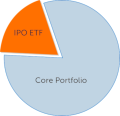LinkedIn, the leading professional social networking website with more than 90 million members worldwide, filed on Thursday with the SEC to raise up to $175 million in an initial public offering. A quick glimpse of the numbers suggests that the company could easily be in the $2-$3 billion range (if not higher) given an annualized revenue-run rate of $250 million, top-line growth of 100% and current EBITDA margins of 18-20%. The company has been cash flow positive for at least three years with annualized cash flow from operations close to $50 million. While the company has been deploying much of that cash back into the business in the form of capital expenditures to support its platform growth, the business model appears highly scalable and should generate meaningful amounts of free cash flow as the business scales.
Here are some key facts on the business and the IPO, as reported by WSJ Blogs: Deal Journal and per LinkedIn's S-1 filing.
From: WSJ/S-1 Filing
LinkedIn says it has more than 90 million registered members. The company's revenue doubled for the nine months ended Sept. 30 from the same period the year before. LinkedIn isn't profitable by U.S. GAAP (accounting standards), and the company said it doesn't expect to be profitable on that basis for 2011, either.
LinkedIn disclosed that 41% of its $161.4 million in revenue for the nine months ended Sept. 30, 2010 was from its "hiring solutions," which allow businesses to scour LinkedIn profiles for appropriate job candidates. Then, 32% of revenue was from advertising and other "marketing solutions." About 27% of revenue is from "premium LinkedIn accounts" with more features. The percentage from hiring solutions has increased from 23% in 2007 and the percentage from premium subscriptions has shrunk from 53% in 2007.
LinkedIn filed to go public with two classes of stock, an arrangement present at other companies including Google, the New York Times Co. and News Corp., owner of The Wall Street Journal. LinkedIn said its dual-class stock "provides our founders, current investors, executives and employees with significant influence over all matters requiring stockholder approval."
Additional metrics:


